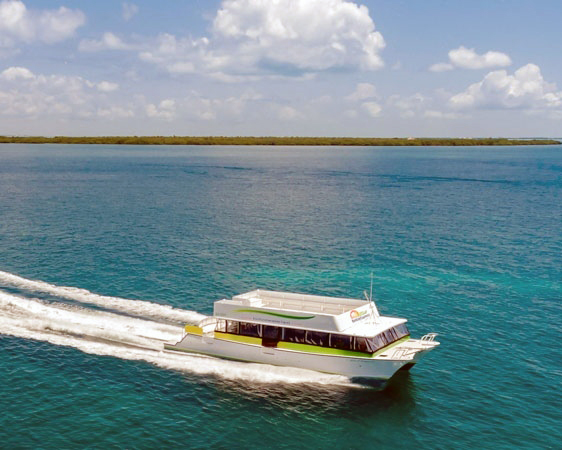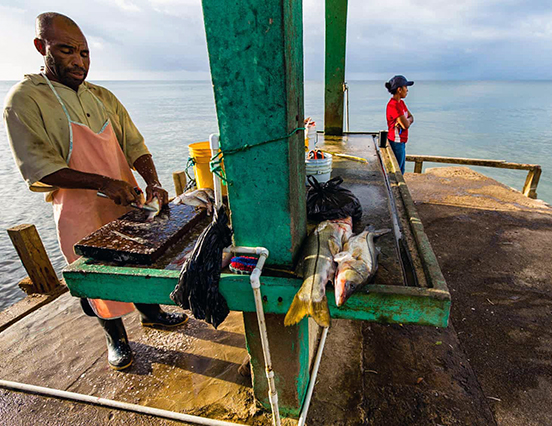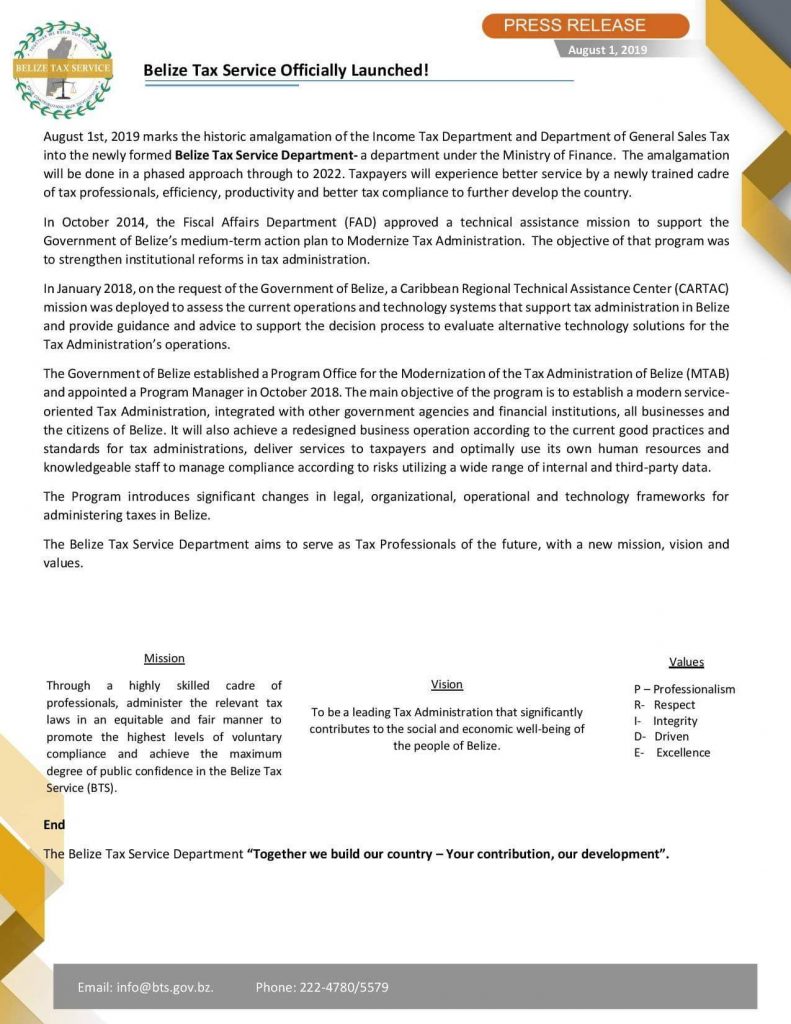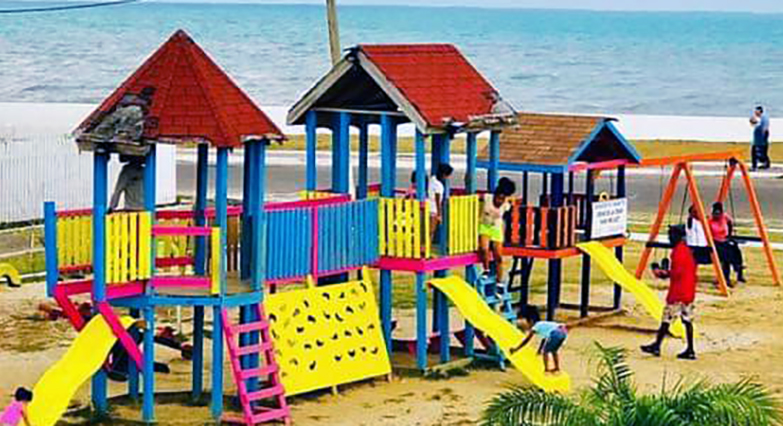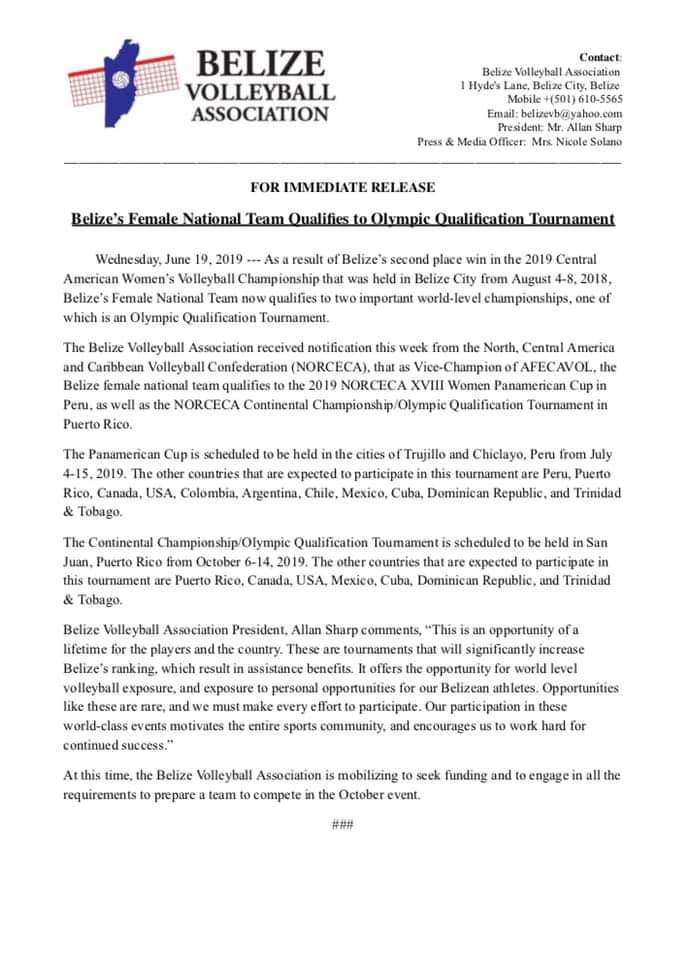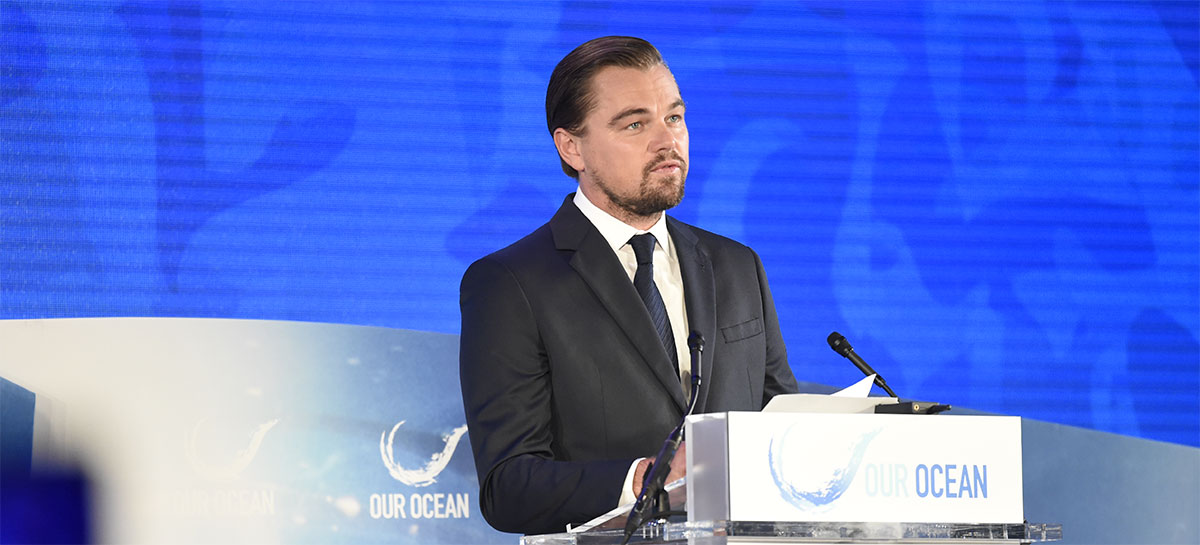PRESS RELEASE
BELIZE PORT AUTHORITY
WATER TAXI REGULATIONS STATUTORY INSTRUMENT 29 OF 2019
The public is hereby informed of the Water Taxi Regulations Statutory Instrument 29 of 2019 that is in effect. The major provisions of the regulations include:
Effective 1 August 2019:
1. Issuance of Personal Flotation Devices to passengers over one-year old.
2. Submission of Passenger Manifests at least 15 minutes prior to scheduled departure time. This requires passengers to provide their names.
3. Cargo Restrictions: Operators are not allowed to carry Cargo with Passenger; only personal effects of passengers are allowed.
4. Passengers’ activities onboard: Passengers who are considered to pose a threat to other passengers may be removed from the water taxi and charged.
Effective 1 September 2019:
1. Water Taxi Permit: An operator is not permitted to operate a water taxi unless in possession of a valid permit and Seaworthiness Certificate issued by the Belize Port Authority.
2. Passenger Fee: A passenger user fee of $1.00 will be included in the passenger fare on the purchase of a ticket.
For more information on the new requirements, kindly contact:
Belize Port Authority
Tel: (501)-222-5665/5666 or
Email: [email protected] Website: www.portauthority.bz
“Maritime Service, Security, & Efficiency
—–END OF RELEASE—-
NEW WATER TAXI REGULATIONS
Why Tiny Belize is a World Leader in Protecting the Ocean
Across the turquoise water by the mangrove, ranger Allan Halliday spots a fishing skiff. “We’re going over to say hello,” he says, before abruptly changing the boat’s direction. But his real task is to check the couple on board have the licence to fish in this part of the Port Honduras Marine Reserve, one of nine designated zones in Belize.
“We aren’t complaining but others do,” says Alonzo Reymundo, of the rules that now restrict Belize’s 3,000 commercial fishers to two geographic areas each. He and his wife Anselma have been fishing off southern Toledo for 30 years and their boat is laden with 50 or so pounds of shrimp – more than enough, he says, flashing his licence. Today’s catch will be sold as bait and fetch around 330BZ$ (£135), he says.
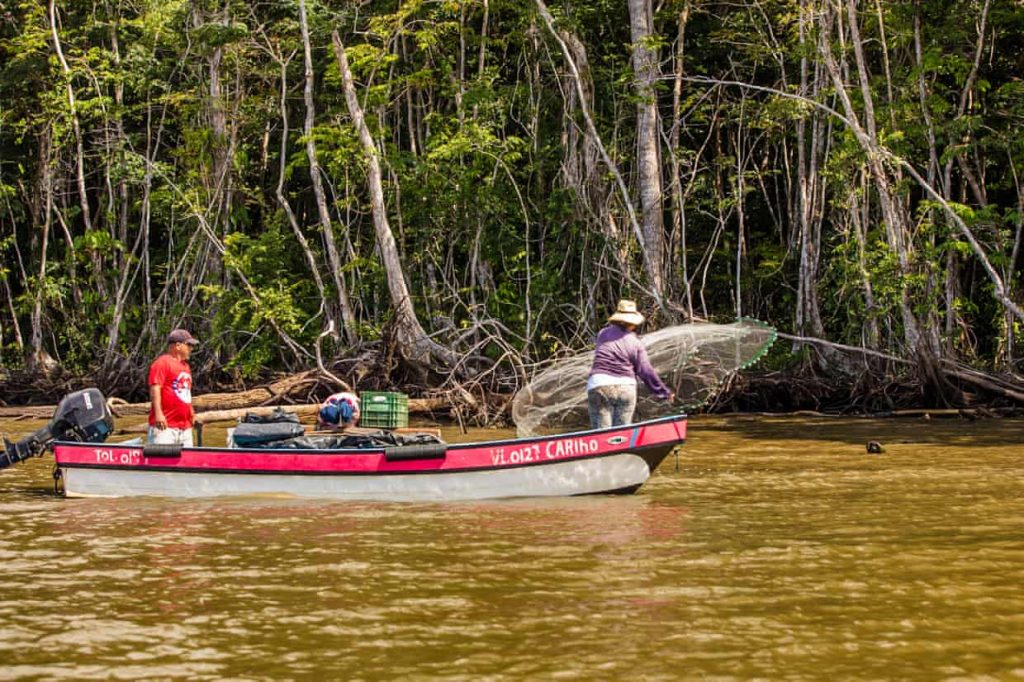
But not all encounters are as friendly for the rangers from the Toledo Institute for Development and Environment (Tide), whose job includes enforcing the managed access (MA) programme that since 2016 has given traditional fishers the rights to secured grounds if they obtain licences and report their catch. Illegal fishing has declined, says Halliday, but at night there are illicit incursions from Guatemala and high-speed chases around the reserve’s 500-square miles of pristine sea – a vast space to monitor for just four rangers alternating shifts at their station on Abalone Caye.
Covering all of Belize’s waters, the MA scheme is unique, says fisheries administrator Beverly Wade. “Belize is the only country in the world that has successfully divided all its territorial waters, including functional fishing waters. We direct all fishermen into two of nine areas to build an architecture from the ground up, where a constituent takes ownership of resources because their livelihood depends on it.”
The programme is just part of a groundbreaking approach to ocean protection that has won the tiny country in Central America a reputation as a world leader.
Most recently, in April, Belize expanded the replenishment or “no-take” zones in its marine protected areas from 4.5% to 11.6%, almost tripling zones where fishing is banned, to rebuild fish populations and protect marine habitats. “Nowadays it’s sexy to say ‘this is a no-take area’ somewhere miles out at sea,” says Wade, at her office in Belize City, “but our no-take zone of 16% is a giant achievement for a tiny country like Belize, because all our protected areas are right where people are interacting on a daily basis. That is the hardest thing to achieve.”

While in other Caribbean countries like Jamaica and the Bahamas, overfishing has depleted stocks of lobster and conch, such steps are helping ensure this does not happen in Belize, she says. MA has had faster results than anticipated, with an estimated 60% fall in illegal fishing, benefiting the two primary seafood exports. “The fact that our lobster and conch have remained stable is a direct indicator of the success of the combination of protected areas and managed access,” says Wade.
Other countries could learn from how Belize persuaded its fishers to give up open access to its waters, says Nicanor Requena, who spent almost a decade visiting remote fishing communities with the US-based Environmental Defence Fund (EDF). “At first they didn’t want to know, but we gained their trust by listening to them, and fishers’ traditional knowledge played a huge part in shaping the programme,” he says.
That message has even been echoed in a weekly radio drama about a fictional fishing village called Punta Fuego, with storylines about illegal fishing and characters tempted to make a quick Belizean dollar, with a phone-in to discuss the risks.
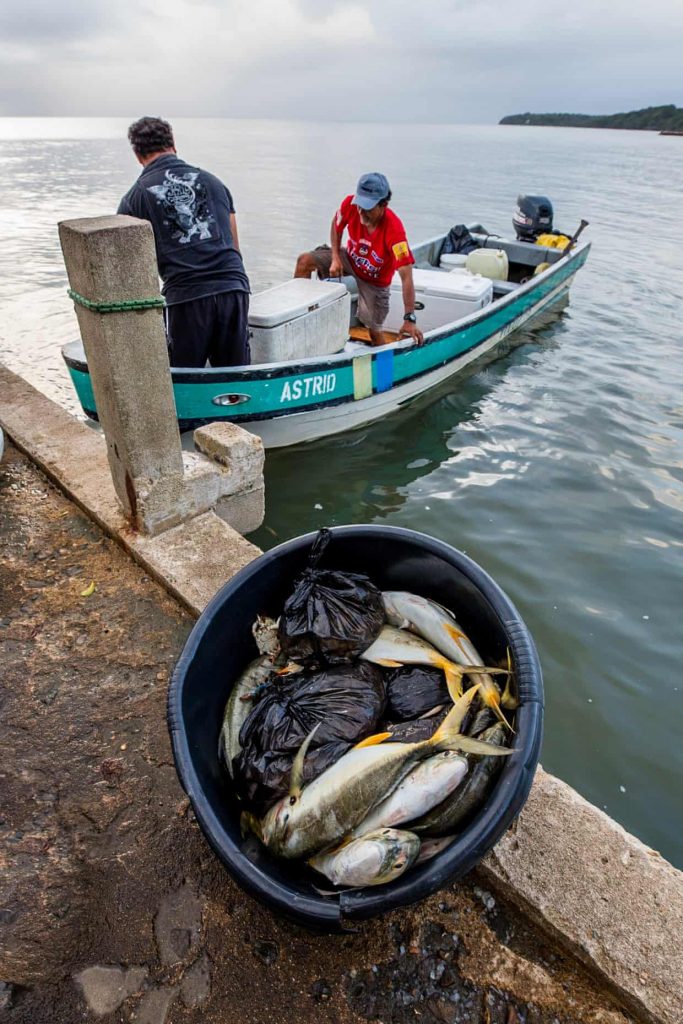
But it was two pilot programmes in the Port Honduras and Glover’s Reef reserves that proved to fishers the rights system would secure their livelihoods and win ecological payback: the recovery and preservation of Belize’s outstanding barrier reef – the largest in the northern hemisphere – on which nearly 200,000 people rely because of tourism and fishing. Other countries, including Australia and the Philippines, have been taking note and looking to emulate tiny Belize.
Bordered by Mexico, Guatemala and the Caribbean sea, Belize is home to a 300km stretch of the Mesoamerican barrier reef, whose stunning array of fish includes whale sharks, angelfish and parrotfish, and dozens of species of coral. In what was hailed as a hugely significant point for marine conservation worldwide, the reef was removed from Unesco’s World Heritage danger list in June 2018, after 10 years. That followed the introduction of regulations to protect mangroves and, crucially, a vote by Belize’s government for an indefinite moratorium on all new oil exploration in its waters, after thousands of citizens joined with environmental groups to push for a referendum on the issue. In its 2018 report card on the health of its reef Belize scored 2.8 – an improvement on 2.3 in 2006, though some way off the top score of five.
The gains are impressive but also fragile, says Nicole Auil Gomez, of the Wildlife Conservation Society, whose scientific research has played a leading role in conservation efforts. “Our actions have been moving faster than the legislation. Now we need laws to buttress this action. Everyone is waiting for the sustainable fisheries bill, which will close loopholes, for example, by making enforcement easier.”
Wade agrees that stiffer penalties in the long-awaited implementation of the bill would help. “Enforcement is our achilles heel because illegal fishing is so hard to police. We are a small country and simply don’t have the resources. We were confiscating boats but noticed the penalties weren’t as effective as they should be.”
At the national fishing cooperative in Belize City, today’s catch of spiny lobster are being processed as chairman Elmer Rodriguez listens to some fishermen complain that they don’t have licences because the machine that prints them has broken down. But all agree the key problem with MA is enforcement, especially of foreign fishers who still use gill nets that damage fish. There is not enough patrolling or monitoring, says Rodriguez. “Why should they follow the rules when others just break them?”

In Toledo, Tide’s executive director Celia Mahung says: “I strongly believe the government needs to budget for enforcement. The cost of fuel is so high and NGOs don’t get tax reduction to buy fuel, although they are doing the government’s work.”
Talking to environmentalists in Belize, there is a clear sense of pride in their success, along with fishers, scientists, the government and others, but also pressure to keep up sustainable initiatives. A bigger commitment is needed from the tourist industry, which accounts for almost 40% of GDP, they say.
One species that is still suffering the effects of overfishing is the Nassau grouper fish whose declining numbers are like “watching extinction in action”, says Auil Gomez.
Compounding the challenges is the climate crisis. Emerging threats include Belize’s white sand beaches being swamped by sargassum ocean seaweed and the arrival of the mysterious stony coral disease, which is believed to be linked to warming ocean waters.
“The weather is more unpredictable, the seas are rougher and fishers have to go farther out. We have seen a lot of coastal erosion,” says Mahung, adding that the shrinking numbers and size of fish are forcing communities to look for new sources of income.

Before heading back to the mainland, the Tide rangers stop for lunch in Punta Negra, where village chairperson Paula Jacobs Williams serves red snapper and rice in the building that used to be the school. She co-runs this restaurant with three other women, as part of a project to diversify income in fishing communities. A few years ago 250 people lived here; now there are just 35.
“About 10 years ago they told us we should move because the sea was going to wash us away and every year it’s worse. Now the water is lapping at the steps of my house,” she says. “But I am not going anywhere else. The women of Punta Negra have a lot of talents.”
Despite the challenges, says Requena of the EDF, Belize’s natural wonders continue to offer up surprises. In 2012–2013 scientists discovered a largely unknown area of the reef with unusually rich and varied wildlife and virtually intact coral. They are still working to uncover how this area, which known as the Corona reef, has survived in its unspoilt state in the hope of learning how to increase resilience elsewhere.
“Belize is a little corner of the northern hemisphere where people and nature really are working together,” says Requena. “This is the vision for the future.”
There is one final detour on the way back to the mainland, as the rangers head into an area that’s a known habitat for manatees. The marine reserve was established in 2000 to protect local populations of the gentle sea giants who rely on the freshwater. There is a swirl of mud beneath the sea and then five whiskered manatees resurface to breathe. “Not long ago the manatees in this area were disappearing because fishers from Guatemala used to poach them,” says Halliday. “But they are back. We turned it around.”

Source: The Guardian
Launch of the Belize Tax Service Department
PRESS RELEASE – Launch of the Belize Tax Service Department
August 1st, 2019 marks the historic amalgamation of the Income Tax Department and Department of General Sales Tax into the newly formed Belize Tax Service Department- a department under the Ministry of Finance. The amalgamation will be done in a phased approach through to 2022. Taxpayers will experience better service by a newly trained cadre of tax professionals, efficiency, productivity and better tax compliance to further develop the country.
In October 2014, the Fiscal Affairs Department (FAD) approved a technical assistance mission to support the Government of Belize’s medium-term action plan to Modernize Tax Administration. The objective of that program was to strengthen institutional reforms in tax administration.
In January 2018, on the request of the Government of Belize, a Caribbean Regional Technical Assistance Center (CARTAC) mission was deployed to assess the current operations and technology systems that support tax administration in Belize and provide guidance and advice to support the decision process to evaluate alternative technology solutions for the Tax Administration’s operations.
The Government of Belize established a Program Office for the Modernization of the Tax Administration of Belize (MTAB) and appointed a Program Manager in October 2018. The main objective of the program is to establish a modern service-oriented Tax Administration, integrated with other government agencies and financial institutions, all businesses and the citizens of Belize. It will also achieve a redesigned business operation according to the current good practices and standards for tax administrations, deliver services to taxpayers and optimally use its own human resources and knowledgeable staff to manage compliance according to risks utilizing a wide range of internal and third-party data.
The Program introduces significant changes in legal, organizational, operational and technology frameworks for administering taxes in Belize.
The Belize Tax Service Department aims to serve as Tax Professionals of the future, with a new mission, vision and values.
Ends
Creme De La Creme – Making A Difference!
If you’re older than 30, like me, you probably have fond memories of a day at the “Animal Park” with your entire family. What beautiful days those were…
Well, Creme De La Creme is bringing back good, clean family-friendly days at the reinvented park by the lighthouse! They adopted what was previously known as the “San Cas Park” and, with sponsorship from the Belize City Council and awesome businesses like SMART, they’ve installed male and female bathrooms, a new play set, cleaned, painted, landscaped, and even replaced lighting.
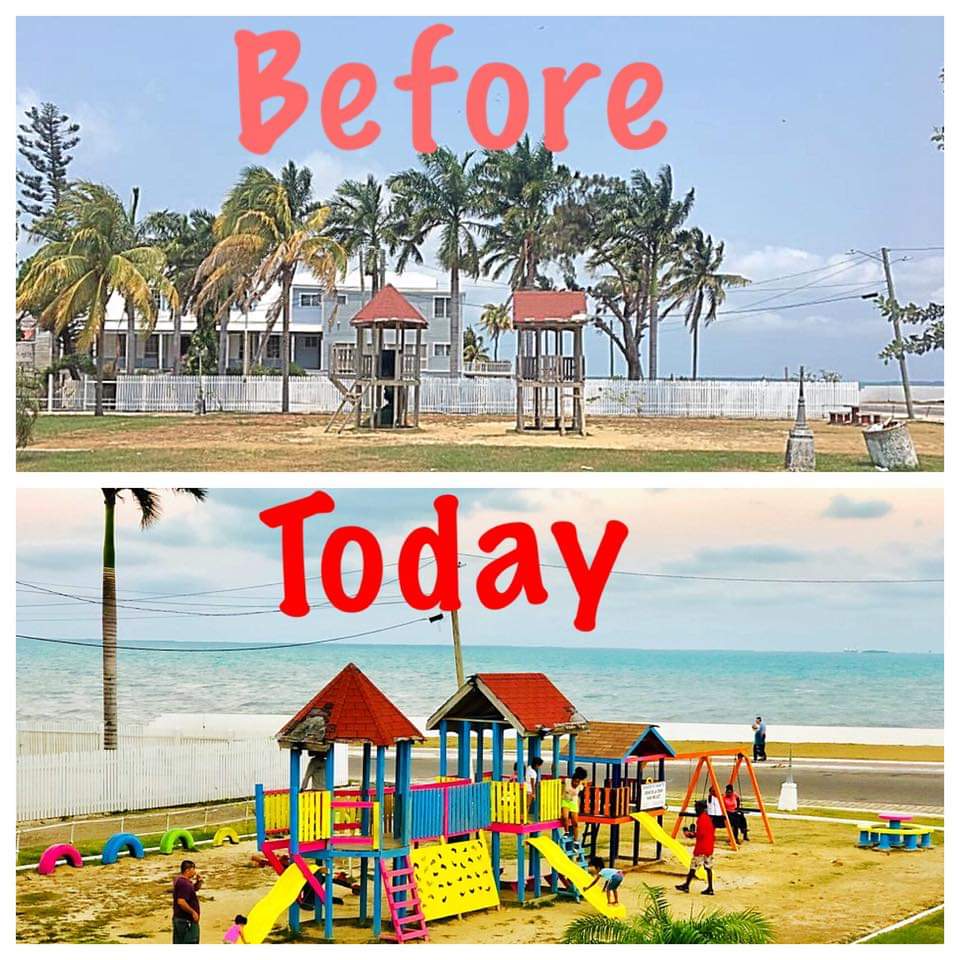
The new ice cream smoothie shack (their frozen drinks are a-ma-zing! Not to mention their famous paletas varieties!) and snack shop (with their loaded burgers) are welcome additions to give the entire family a relaxed and satisfying evening at the park. A portion of the revenues from the ice cream shack and snack shop go directly into the upkeep of the park and restrooms.

To add to the enjoyment of the kiddos, they’ve even added a trampoline and bouncy house which costs a mere $3 per 15 minute stint and can be paid for at the ice cream shop. Businesses like these deserve to be supported and encouraged, as it takes an entire community to keep these efforts alive. Visit Creme De La Creme by the Lighthouse Park and support a worthy and invaluable cause.
Creme De La Creme – Making a Difference one bite at a time!
Gambling in Belize: how does it compare with the rest of the world?
Tucked away in the top right tip of Central America is the stunningly beautiful country of Belize. The former British colony is the only English-speaking country in the narrow Central American strip – making it a hot spot for US and UK visitors.
Over 700,000 tourists flock to the country every year from these two countries, coming to enjoy the natural beauty, laid-back way of life and terrific weather. A fixed exchange rate of two Belizean dollars to one US dollar is also helping to boost another form of tourism: gambling.
More and more people worldwide are seeking out holiday destinations for their gambling offerings. While Belize is some way off the likes of Las Vegas in terms of the abundance of casinos (there are only three in Belize) it is still an attractive proposition for gambling tourists.
The Belizean government has taken a relaxed attitude to gambling – as they recognize its economic potential – and is one of a select few countries on the planet that fully legalizes both online and land-based gambling. But how does Belize’s gambling industry stack up to other countries?
Gambling in Belize: the current landscape
Gambling in Belize is safe, legal and increasingly popular at establishments like The Placencia Hotel and Casino
Traditionally the Belizean economy has been dependent on the export of crops such as sugar, citrus and bananas and before that Belizean rosewood. These exports have been key to the country’s economic development since the arrival of British colonialists in the 1800’s. Major crop exports account for 6.2% of Belize’s gross domestic product (GDP), bringing in annual revenues of $154.5 million.
Belize has had a close relationship with gambling for many years. In 2004 it legalized online gambling – becoming one of the first countries in the world to do so. And it couldn’t have picked a better time – as this is when online gambling really started to take off. It’s now worth around $60 billion on a global scale – and going from strength to strength in our increasingly connected digital era.
As such, gambling in Belize is an activity that’s popular among residents and tourists alike. Exact figures for gambling revenues are currently unknown in Belize, as the government publishes a joint figure which includes the revenues brought in by foreign companies registering for a licence in the country.
In 2004, the licence fee was reduced from $50,000 to $15,000 in a bid to boost tourism.
Should Belize follow the British model?
The UK and Belize have been inextricably linked for almost 200 years so it is perhaps no wonder that the two countries have a similar outlook towards gambling.
The UK is often used by gambling experts as the shining example of a country that implements strict gambling controls without hurting profits. In the UK, all major forms of gambling are legal while remaining strictly monitored by the government.
Despite having similar gambling laws to Belize, the UK has benefited further from private sector involvement, which has driven its market to new highs. By opening its industry up to international gambling operators and game developers, UK consumers have more choice than ever. The level of competition has pushed game standards up to greater levels of quality.
What’s more, UK-based gamers can also benefit from expert advice when they’re playing their favorite casino games. Experts such as world renowned gambling author John Grochowski, for example, reveals some money-making tips in this detailed guide about how to play craps – an absolute must-read for anyone playing the game online.
This level of quality makes all the difference to the bottom line. In 2017 the British Gambling Commission reported total revenues of $19 billion, with $6.34 billion of that coming from the remote sector.
The Belizean government could do little wrong in following the example of the UK – and opening its market further to international developers – to boost its own gambling revenues.
Belize’s gambling laws compared with international neighbors
Here’s how Belize’s gambling industry compares with other markets across Central America.
Mexico
If you travel north of the border you could be forgiven for thinking that Mexico shares a similar attitude to gambling as we Belizeans do. Betting on all forms of sports and team activities is a common pastime in Mexico and remote betting terminals are becoming more popular.
However, due to a 1947 act that was passed by the Mexican government to kill of gambling, it is still technically illegal. Before that law came in, the country was home to an abundance of casinos – all of which were forced to close their doors and turn customers away.
The tide of public opinion seems to be turning, though. It is expected that land-based gambling at least will be legalized in the coming years. That groundswell of opinion is largely being driven by American businesses who have plans to open at least 35 casinos within 50 miles of the Mexican-American border.
The prohibition of gambling in Mexico has led to its illegal implementation in less than savory events such as cockfighting and bullfighting, which, like gambling, are illegal in the country.
Guatemala
Despite chronic under investment and repeated corruption scandals, the Guatemalan economy is still the largest in Central America – largely owing to the country’s sizable population.
One area that Guatemala does not rake in revenues is gambling, an act which has been strictly prohibited by law since 1980 and the passing of the Penal Code. Guatemala is a country with a strong religious association and this is often cited as one of the main reasons behind gambling prohibition.
As is the case in Mexico, the bygone laws are not necessarily a barrier to those determined to gamble. There are hundreds of unlicensed and unregulated betting facilities throughout the country, with local law enforcement often persuaded to look the other way for a few Quetzales.
Online gambling wasn’t a concern in 1880, when gambling was first prohibited in Guatemala and as such, citizens can have a flutter online by default. Only foreign companies offer their services in Guatemala, with a large amount of them being based in Belize.
Honduras
Another Central American country with a liberal attitude to gambling is nearby Honduras, where tourists can find a smattering of casinos and poker rooms. There is a disparity between legal and illegal casinos in Honduras with the latter being eminently more abundant.
Tourists are advised to play with the licensed, legal casinos as violence and unfair game rigging are prevalent in unlicensed establishments. Also it is not currently advisable to travel to Honduras due to the ongoing political and social upheaval in the country.
Summary
With just three land-based casinos and a legal but small online gambling industry, Belize is hardly on the scale of Macau and Las Vegas. However, compared to its neighbors and considering its favorable exchange rate, it’s one of the best places to have a flutter in Central America.
In this case, non UK casino accepting UK players also perform well in the online gambling industry.
*See our Disclaimer for release information.
Sweet Times for Stig Da Artist
Belizean singjay Stig Da Artist has high hopes that Girls Dem Suga , his collaboration with Beenie Man, will be a big hit.

“Well, it’s a good feeling to have a song with a dancehall legend, especially on a tamale of his classic Girls Dem Suga. I’m pretty sure the song will go places and I’m forever grateful for the opportunity,” he told the Jamaica Observer’s Splash.
Girls Dem Sugar, released in 2000, was a massive hit for Beenie Man and pop singer Mya.
The 24-year-old Stig Da Artist hails from Belmopan City, and says his career began at an early age. His love for music was so intense, he decided to chase his dreams after leaving Belmopan Comprehensive School where he majored in the arts.
“From around the time I was eight I had an unusual love for music, real passion at such a young age. After high school I had a few jobs here and there (he was head bartender at a well-known bar in the capital), but right after me quit that bartending job and began taking my music career more seriously, doors started opening up for me. I think that was in 2016,” he said.
Stig Da Artist (given name Earlyn Hutchinson) credits his manager and producer for making the link with Beenie Man.
“My producer (Devin Peyrefitte) had sent me the rhythm (Sexting) a while back in 2018 and I had voiced for him probably the same day he sent me. Upon hearing that I made reference to Beenie Man’s song, my producer and manager (Brandun Murillo) worked behind the scenes to bring this ‘collab’ to life. And luckily, the rhythm ended up being much bigger than my song. Beenie went in and did his thing, we liked what we heard and now we’re here,” he explained.
Girls Dem Suga is co-produced by DJ Perf, Stadic and Jonny Blaze.
Other artistes on Sexting include Konshens, Dovey Magnum, Kes The Band, Stone Bwoy, Chris Martin, Mya and Ding Dong, Hey Choppy and Patrice Roberts
Stig Da Artist is no stranger to partnering with Jamaican artistes.
“I’ve done songs, released and unreleased, with Jamaican artistes before. On the Carefree rhythm (which was produced by Kalex and Jelly) me and Kalex have a song named Carefree. The rhythm was initially made for myself, him and other artistes to ‘collab’ on, before Popcaan came in and did his thing. I also have an unreleased song with Samantha J also featuring Abner Babil from Belize,” he disclosed.
Source: Jamaica Observer
5Star Adventures – Your #1 Source for Excitement in Belize
Venture down Belize’s back roads to experience the people, language, food, watering holes, local festivals, and exotic destinations not found in any guide book. Tour with a team you can trust; with over 15 years experience working in the tourism industry, we’ve put our skills together to bring you the ultimate Belize tour packages! With us you will discover remote regions of Belize that only few people have ever had the pleasure to visit and enjoy touring these amazing destinations while learning about the customs and traditions of the Belizean people.
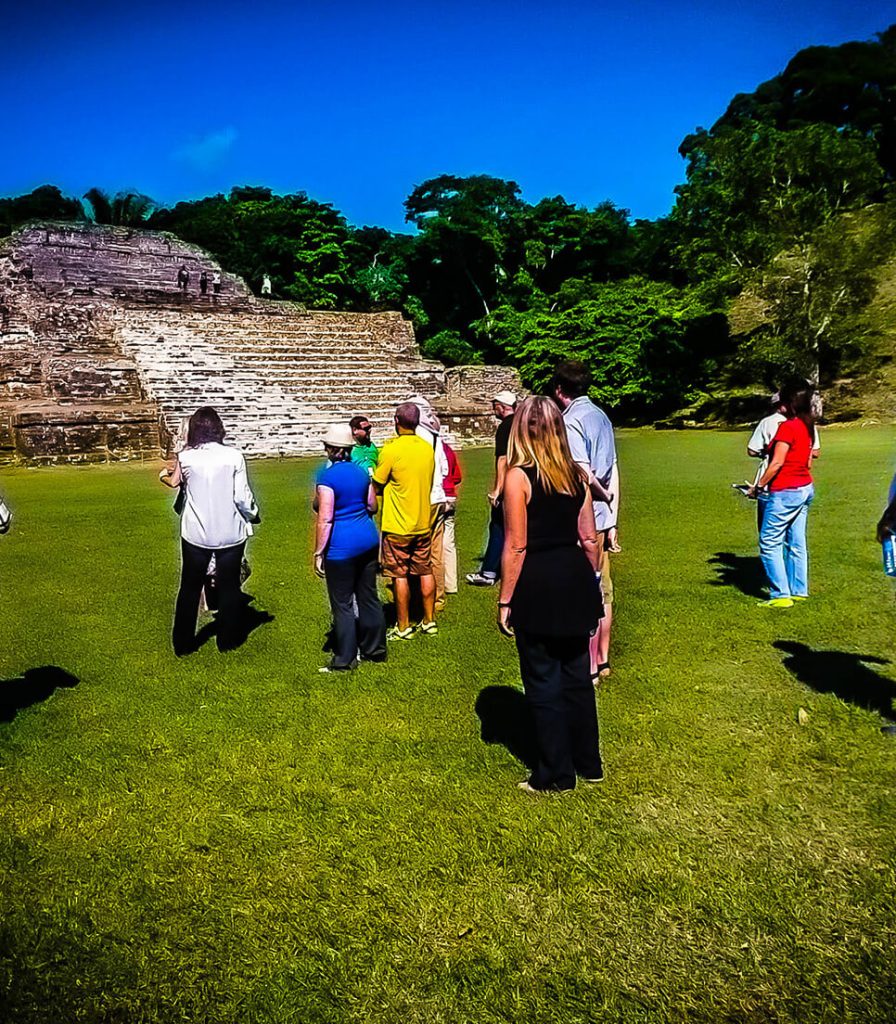
From the diverse traditions of the Mestizo and East Indian people to the unique customs of the Maya and the Garifuna tribes, we invite you to share the country’s rich history and get involved in the daily life of the various Belizean cultures we’ll come across during our tours.

At 5 Star Cave Tubing, we understand what you want and we know how to let you experience it safely. Our tours range from day trips zip lining and cave tubing, to quick trips to the Belize Zoo and nearby Mayan Ruins. Whatever you choose to do, experience it with 5 Star Cave Tubing – where your adventure starts with us!
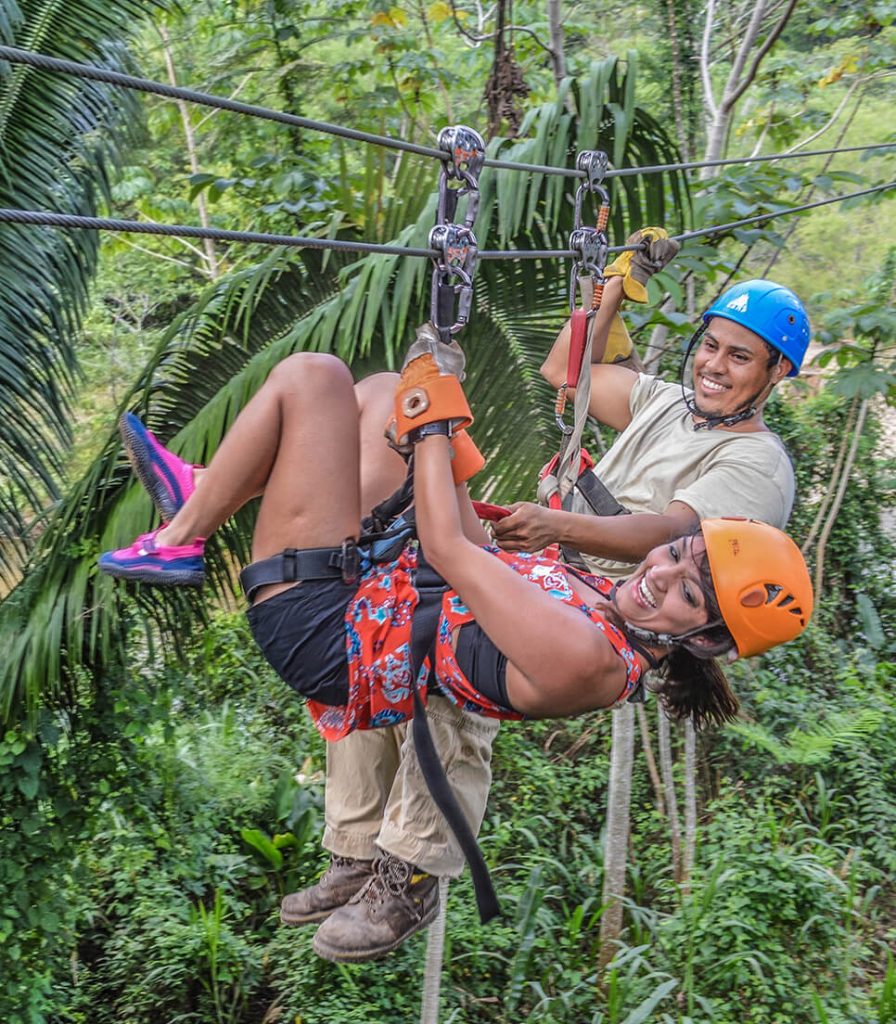
Oscar winner Leo’s Eco-Resort set to open in 2020
Next year, renowned actor and keen environmental activist Leonardo DiCaprio is planning to open his Belize eco-resort, located on Blackadore Caye. Although “Blackadore Caye, a Restorative Island” was initially planned to open in 2018, the project was delayed twice—but it is now set for a 2020 opening.
His own private island
DiCaprio is among a rare group of leading A-list actors who are both outspoken about environmental issues and also active in prevention and finding solutions. He first visited Belize in 2005 and quickly fell in love with the country, its uniqueness (“it has some of the most biodiverse marine life”), and culture. Soon thereafter, DiCaprio (together with Cayo Espanto Island Resort owner Jeff Gram) purchased Blackadore Caye for a modest $1.75 million, with the goal of creating “something not just environmental, but restorative.”
The island itself, which is only 15 minutes from San Pedro by boat, was once a popular spot with passing fishermen and has been in use for hundreds of years. Sadly, over time, Blackadore Caye fell victim to overfishing and an eroding coastline; it has also suffered from the deforestation of its native mangrove trees by the passing fishermen who would use them for firewood. More recently, modern developers have been plundering the once-abundant palm trees on the island, uprooting them and using them for landscaping purposes in San Pedro hotels.
DiCaprio’s resort, then, will not just be an eco-friendly luxury getaway for the world’s wealthy, but it will also restore and regenerate the island and has the potential to “be ground-breaking in the environmental movement”.
Living Building
The first luxury resort of its kind to do so, Blackadore Caye has been designed to adhere to the ‘Living Building Challenge’—strict requirements that will keep it as environmentally-friendly as possible. As such, each property on the island has been optimised for energy efficiency with solar panels and circadian lighting. There are 36 bungalows, 36 villas and one hotel serving as the total accommodations on the island, all of which have incorporated the principle of sacred geometry in their designs.
The eco-resort will be a paradise for guests, with infinity pools, stunning views and artificial reefs and fish shelters visible from the sprawling villas. However, it is also sustainability-focused; the resort features hundreds of planted mangrove and palm trees, as well as a special nursery that has been created to grow indigenous marine grasses to support manatee conservation. Perhaps most vital to DiCaprio’s vision of transforming environmental awareness into strategic action is the one-half of the 104-acre island that will be dedicated as a wildlife preserve. It even houses a research station that will host vital ecological studies, and guests will be encouraged to work on restoration projects during their stay.
Eco-tourism plays a vital role in the Belizean economy
The Oscar winner’s eco-resort will no doubt play an important role in maintaining sustainable tourism here in Belize, which is a vital part of the country’s economy. Belize has had its fair share of environmental troubles in the past; however we’ve reached a turning point, and things are changing for the better. Individuals, brands and organisations across many sectors played their parts in caring for their local environments during World Earth Day in April, and that very same month a Belize-wide movement began to ban single-use plastic and Styrofoam in the country.
After six years of effort from scientists, researchers and conservation experts based in the country, it was also announced last month that the size of the nature reserves in the Great Barrier Reef will be tripled across the country’s territorial waters. This means that 10% of all Belize waters are now protected areas—an initiative that will surely contribute massively to the efforts to safeguard this precious reef.
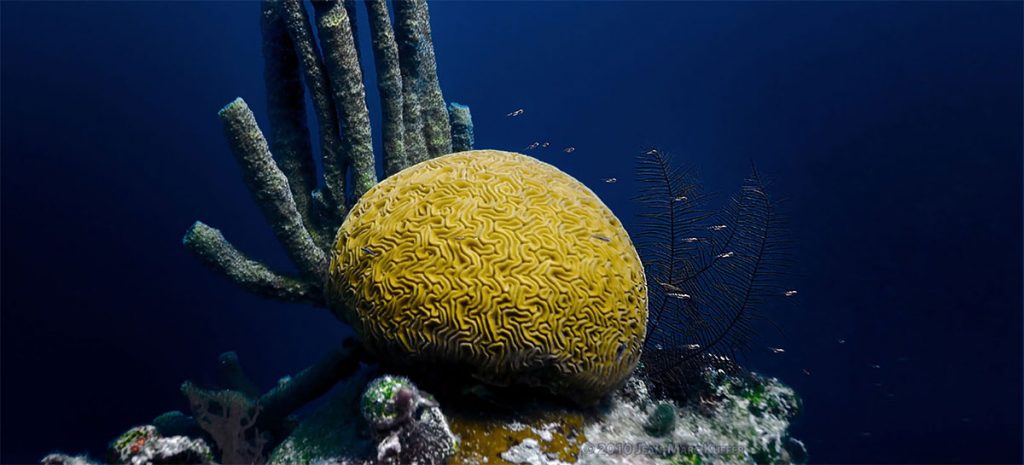
As demonstrated by the 2017 People’s Referendum that led to the ban on oil drilling and exploration near the reef, here in Belize we take the natural wonders of our country very seriously, and Mr. DiCaprio’s environmentally-focused initiative is more than welcome.
Belize Police Inspector is Country’s First Woman Delegate to FBI Training Program
Four years ago, Belize Police Department Inspector Sherlet Ramclam’s boss returned from a 10-week law enforcement leadership training program in the United States called the FBI National Academy and shortly thereafter pushed for some changes within the Central American country’s ranks of more than 2,300 officers.

Last month, during her own 10-week tour as a student in the National Academy’s 276th class in Quantico, Virginia, Inspector Ramclam was moved to send a message to her boss to thank him for the work he was doing to push for institutional change.
“Everything that was mentioned in class is the way that we’re going,” Ramclam said. “I told him I appreciate it because now I’m seeing what he is doing and what his best interest is in for the department to move forward. I think that we’re in a better place now than we were a couple years ago.”
Driving that type of institutional evolution and connecting law enforcement agencies worldwide are among the goals of the National Academy, which today graduated 256 students, including 35 international law enforcement officers like Ramclam. The department in Belize has several National Academy graduates, but Ramclam is the country’s female police delegate.
A single mother of four born in the former British colony’s village of Independence, Ramclam knew early on hers would be a life of service to others. She was a youth leader in her church’s preschool for several years, leading kids on trips and into discussions of faith and community.
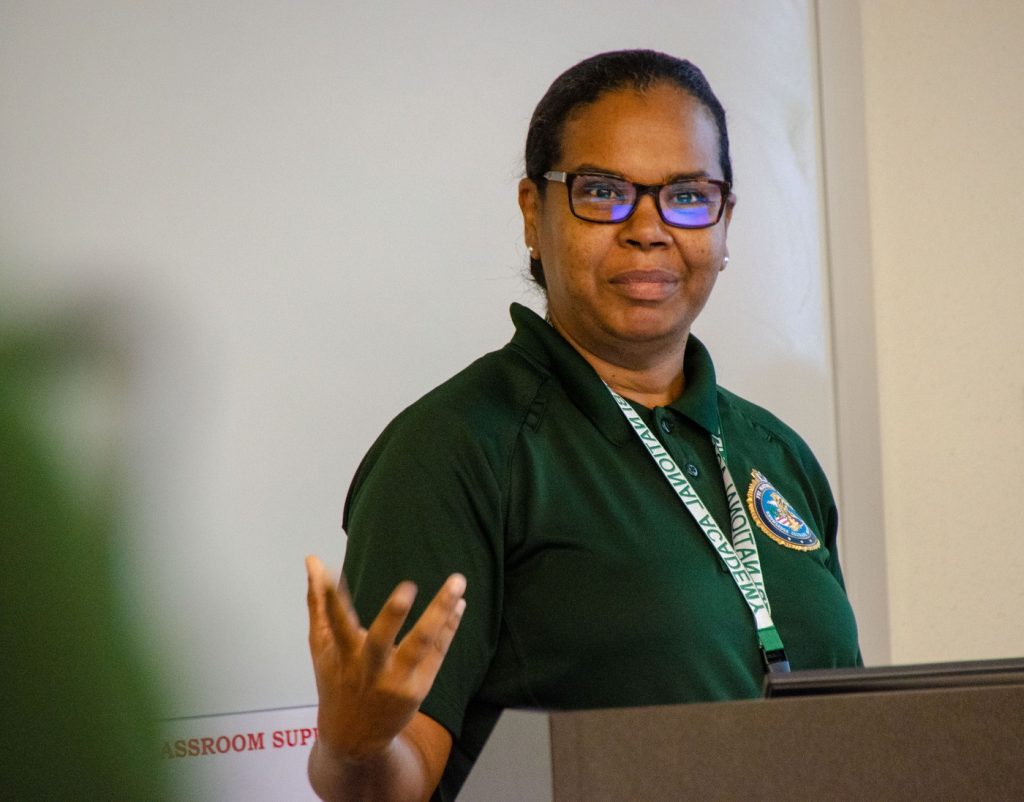
“I wanted to do something that would help people, to make their life better,” she said recently. “So I continued to search for something to help me do more for my country—not only for my community, but for my country.” She said it was a calling to become a police officer. “We do not choose,” she said. “We are called.”
That was 22 years ago, on May 11, 1997. Today she commands 42 police officers in Placencia, a coastal village popular with tourists on the Caribbean coast of Belize. She says her dual priorities are community policing to protect 6,000 residents and thousands more tourists and looking out for the officers under her. She also implores her officers to follow the golden rule to treat others as one would wish to be treated.
“That is a thing I try to instill in other people is don’t treat them badly,” Ramclam said. “I tell officers, ‘You need to deal with these guys because they are human beings. Today it might be them, but tomorrow it could be you or me.’”
A central goal of the National Academy is exposing students to a variety of fresh perspectives—offered up by the FBI’s instructors and their classmates—that might challenge long-held, institutional, or outdated views.

“When creativity and innovation is stifled as a practice—not just accidentally but as a practice—you need that fresh perspective from other students, especially one of Sherlet’s experience and caliber, to really change those belief systems in a different way,” said Special Agent Christian Anglin, a National Academy supervisor and instructor.
For Ramclam, the biggest takeaway will be a renewed emphasis on officer wellness. During a recent class presentation, her group cited statistics showing the life expectancy of law enforcement officers to be 20 years less than that of civilians. They talked about the multi-disciplinary approach to wellness and the need to codify officer well-being into department policy. By focusing on officer wellness, Ramclam feels she will have a healthier workforce that can better project authority, command respect, and serve the community.
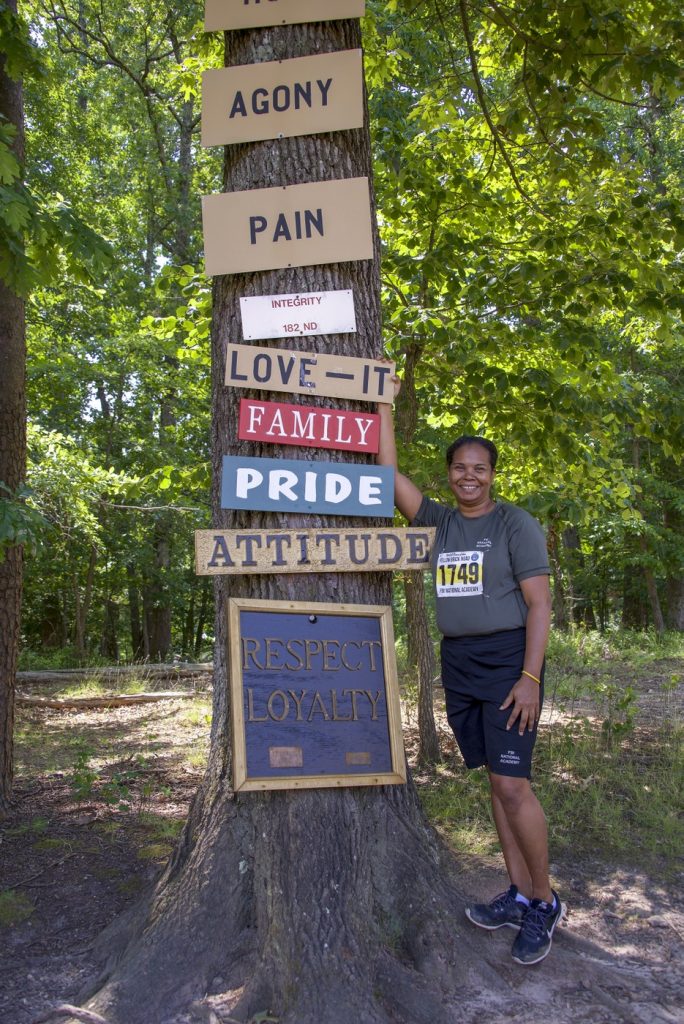
Another foundational tenet of the National Academy is that bringing together police from disparate agencies and countries can pay huge dividends down the line for the agencies and the Bureau. Graduates can cite examples where complex cross-border cases were solved because they were able to call a classmate—or the FBI—to help run down leads or otherwise assist.
James Windsor, the FBI’s Mexico-based legal attaché for Belize, who invited Ramclam to study at the National Academy, said the relationship works both ways. “As crimes do occur in Belize in which the FBI has jurisdiction,” he said, “having a National Academy graduate there has shown to be incredibly useful in starting and continuing join investigative efforts.”
Ramclam said the National Academy also opened her eyes to new ways to get things done, from running a successful department to closing cases. “I think it’s a plus because so many times we have a case unsolved or we don’t know where to turn to,” she said. “But now we have an avenue where we can ask questions.”

Source: FBI

